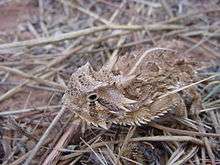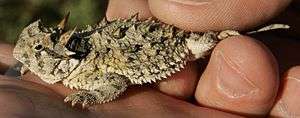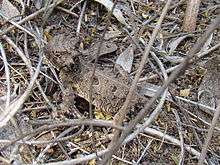Texas horned lizard
| Texas horned lizard | |
|---|---|
 | |
| Scientific classification | |
| Kingdom: | Animalia |
| Phylum: | Chordata |
| Class: | Sauropsida |
| Order: | Squamata |
| Family: | Phrynosomatidae |
| Genus: | Phrynosoma |
| Species: | P. cornutum |
| Binomial name | |
| Phrynosoma cornutum (Harlan, 1825) | |
| Synonyms | |
|
Agama cornuta Harlan, 1825 | |
The Texas horned lizard (Phrynosoma cornutum) is one of about 14 North American species of spikey-bodied reptiles called horned lizards. P. cornutum ranges from Colorado and Kansas to northern Mexico (in the Sonoran desert), and from southeastern Arizona to Texas.[2] Also, isolated, introduced populations are found in the Carolinas, Georgia, and northern Florida.[3] Texas horned lizards may also be native to Louisiana[4] and Arkansas.[5]
Etymology
The horned lizard is popularly called a "horned toad", "horny toad", or "horned frog", but it is neither a toad nor a frog. The popular names come from the lizard's rounded body and blunt snout, which give it a decidedly batrachian appearance. Phrynosoma literally means "toad-bodied" and cornutum means "horned". The lizard's horns are extensions of its cranium and contain true bone.
Description
The Texas horned lizard is the largest-bodied and most widely distributed of the roughly 14 species of horned lizards in the western United States and Mexico. The average Texas horned lizard is 69 mm (2.7 in) in snout-vent length,[6] but the upper boundary for males is 94 mm (3.7 in) and for females it is 114 mm (4.5 in).[7]
Defensive behavior
Although its coloration generally serves as camouflage against predation, when threatened by a predator, a horned lizard puffs up and appears very fat, which causes its body scales to protrude, making it difficult to swallow. The Texas horned lizard, along with at least three other species of the genus Phrynosoma, also has the ability to squirt an aimed stream of blood from the corners of the eyes and sometimes from its mouth for a distance up to 5 ft (1.5 m). This not only confuses would-be predators, but also the blood is mixed with a chemical that is foul-tasting to canine predators such as wolves, coyotes, and domestic dogs. This novel behavior is observed to be very effective in defense.
Diet and decline
About 70% of the Texas horned lizard's diet is made up of harvester ants, though they supplement these with termites, beetles, and grasshoppers. In recent years, the species has declined by about 30% of its range, though it may be making a comeback. The decline is usually blamed on overuse of pesticides and the spread of nonnative, highly aggressive and fiercely territorial red imported fire ants. Both eradicate harvester ant colonies, destroying the lizard's principal source of food. The Texas horned lizard is now a protected species, and it is illegal to take, possess, transport or sell them without a special permit.
Current research
Horned lizards are primarily studied by researchers at Texas Christian University, the nearby Fort Worth Zoo, and Dallas Zoo[8] with raw data and fieldwork done by state employees. Since 2010, the Dallas Zoo has been conducting a mark-and-recapture study on Texas horned lizards[9] on the Rolling Plains Quail Research Ranch, a 4,700-acre preserve located in Fisher County, Texas. Dallas Zoo researchers capture animals, tag them, collect data, and release them.[10] The project’s goals are aimed at shedding light on the life history, population density, and determining ecological conditions best suited for this threatened species. Further research toward their preservation is funded by sale of horned lizard "Keep Texas Wild" license plates.[11]
In addition, the Dallas Zoo is currently working to establish a captive colony[12] of animals with several key reproductive successes taking place in 2015.
Temperament
Despite its fierce appearance, Texas horned lizards are extremely docile creatures. Since they have very few natural predators, they are not at all aggressive. Captured horned lizards lie completely limp in a human's hand or pocket, playing dead, so they made excellent pets before they were threatened. Today, it is illegal to disturb or keep this lizard without a state permit.
The Texas horned lizard is a sunbather, and requires bright sunlight to produce vitamin D. Deprived of sunlight, the animal is unable to produce vitamin D and can suffer from vitamin deficiency. So, horned lizards are most often found along the side of roads or other open, rocky areas, where they can lounge and take in sunlight.
At night, the lizard buries itself in sand.[13]
Otherwise, horned lizards are most often found near harvester ant hills. Although they prefer to move very little, horned lizards can move quite fast if they feel a predator is in the area, and dart into thick grass and foliage to escape. Horned lizards are also excellent diggers, and can quickly burrow underground to escape threats.
Genetic mutation
Research aimed at preservation has revealed the Texas horned lizard is extremely genetically diverse, and isolated pockets of genetically distinct subspecies have been found throughout Texas. Though each of these subspecies is physically identical to all other subspecies, they are likely specifically adapted for the region in which they are found. This makes it difficult to know how one subspecies would survive if it were reintroduced into a new area.

The most numerous and widespread subspecies of Texas horned lizard is found in the Panhandle region of Texas. Other distinct subspecies have been identified in East Texas, the Hill Country, and along the coastline. It is not known whether these subspecies can reproduce with one another over the long term, making preservation of all of the subspecies even more crucial to the animals' preservation. It is also unknown whether any of these subspecies will show a particular resistance to the pesticides and fire ants threatening them.
In Native American religion and art
Some Native American peoples regard horned lizards as sacred. The animal is a common motif in Native American art in the Southwestern United States and Mexico.
In popular culture
The Texas horned lizard is the state reptile of Texas[14] and, as the "horned frog", is the mascot of Texas Christian University.[15]
References

- Notes
- ↑ Hammerson, G.A. (2007). Phrynosoma cornutum. The IUCN Red List of Threatened Species doi:10.2305/IUCN.UK.2007.RLTS.T64072A12741535.en. Note that this species is in sharp decline over a large part of its historical range and is listed as a threatened species by the State of Texas.
- ↑ "Phrynosoma cornutum". Phrynosoma.org. Retrieved 2009-06-27.
- ↑ "Texas Horned Lizard". Lizards of Georgia and South Carolina. University of Georgia. Retrieved 2009-06-27.
- ↑ "Amphibians and Reptiles of Louisiana". Brad Glorioso. Retrieved 2009-06-27.
- ↑ "Texas Horned Lizard (Phrynosoma cornutum)". Herps of Arkansas. Retrieved 2009-06-27.
- ↑ Munger, James C. (1986). "Rate of Death Due to Predation for two Species of Horned Lizard, Phrynosoma cornutum and Phrynosoma modestum". Copeia. American Society of Ichthyologists and Herpetologists. 3 (3): 820–824. doi:10.2307/1444970. JSTOR 1444970.
- ↑ Munger, James C. (1984). "Home ranges of horned lizards (Phrynosoma): circumscribed and exclusive?". Oecologia. 62 (3): 351–360. doi:10.1007/BF00384267. JSTOR 4217328.
- ↑ "Texas horned lizards". Wix.com. Retrieved 2015-12-16.
- ↑ "Dallas Zoo Texas Horned Lizard Conservation | www.dallaszoo.com". www.dallaszoo.com. Retrieved 2015-12-16.
- ↑ Campitelli, Anna. "Operation Horned Lizard: Saving a Texas Icon | Dallas ZooHoo!". Retrieved 2015-12-16.
- ↑ TxDMV-Special Plate Order Application. Rts.texasonline.state.tx.us. Retrieved on 2016-10-25.
- ↑ "Dallas Zoo Welcomes Iconic Texas Hatchlings". ZooBorns. Retrieved 2015-12-16.
- ↑ Breen, John F. Encyclopedia of Reptiles and Amphibians. T.F.H.
- ↑ "Texas State Symbols". Texas States Library and Archives Commission. Retrieved 2009-06-27.
- ↑ Gibson Roach, Joyce (March 2001). "Horned Frog defined". TCU Magazine. Texas Christian University.
- Sources
External links
| Wikimedia Commons has media related to Phrynosoma cornutum. |
- HornedLizards Yahoo Group: Horned Lizard Preservation and Discussion
- Horned Lizard from the Handbook of Texas Online
- www.TexasHornedLizard.com
- Phrynosoma.Org
- Horned Lizard Conservation Society
